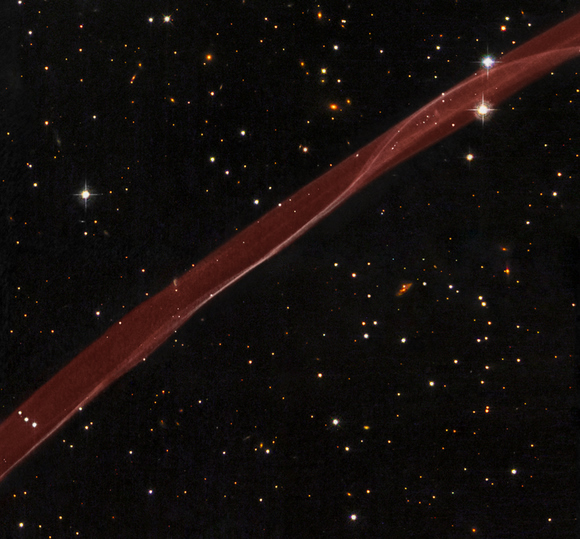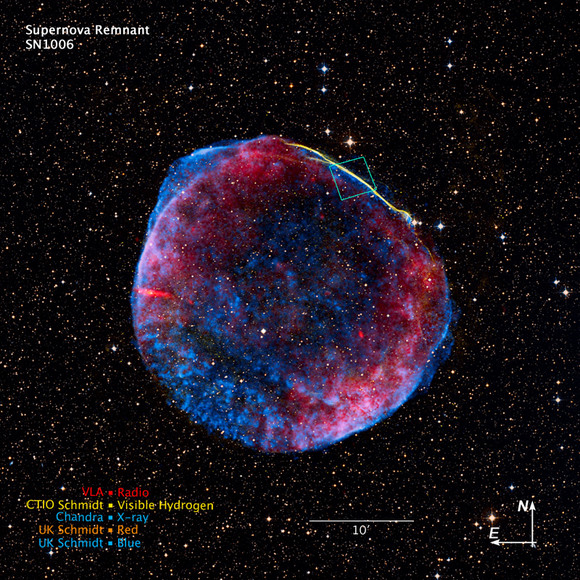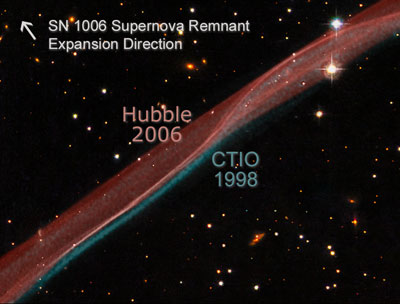Back in 1006 A.D, observers from Africa to Europe to the Far East witnessed and recorded the arrival of light from what is now called SN 1006, a tremendous supernova explosion caused by the final death throes of a white dwarf star nearly 7,000 light-years away. One Egyptian astronomer recorded the object was 2 – 3 times as large as the disc of Venus and about one quarter the brightness of the moon. The supernova was probably the brightest star ever seen by humans, visible even during the day for weeks, and it remained visible to the naked eye for at least two and a half years before fading away. Remnants of this supernova are still visible to telescopes, and the Hubble Space Telescope captured this close-up a filament of the shock wave of the explosion, still reverberating through space, seen here against the grid of background stars. The full image of SN 1006 is pretty impressive, too…
SN 1006 has a diameter of nearly 60 light-years, and it is still expanding at roughly 6 million miles per hour. Even at this tremendous speed, however, it takes observations typically separated by years to see significant outward motion of the shock wave against the grid of background stars. In the Hubble image shown here, the supernova would have occurred far off the lower right corner of the image, and the motion would be toward the upper left.
It wasn’t until the mid-1960s that radio astronomers first detected a nearly circular ring of material at the recorded position of the supernova. The ring was almost 30 arcminutes across, the same angular diameter as the full moon. The size of the remnant implied that the blast wave from the supernova had expanded at nearly 20 million miles per hour over the nearly 1,000 years since the explosion occurred.
In 1976, the first detection of exceedingly faint optical emission of the supernova remnant was reported, but only for a filament located on the northwest edge of the radio ring. A tiny portion of this filament is revealed in detail by the Hubble observation. The twisting ribbon of light seen by Hubble corresponds to locations where the expanding blast wave from the supernova is now sweeping into very tenuous surrounding gas.
The hydrogen gas heated by this fast shock wave emits radiation in visible light. Hence, the optical emission provides astronomers with a detailed “snapshot” of the actual position and geometry of the shock front at any given time. Bright edges within the ribbon correspond to places where the shock wave is seen exactly edge on to our line of sight.
Original News Source: HubbleSite




hubble keeps rockin on !!!
The moon base should be named that as well in rememberence of such a fine machine…
It’s highly reminscent of Saturn’s F Ring. One gets the impression that there is flow along the length of the structure, and there is a hint of helicity in the bright strands.
I absolutely love Hubble. The images it brings us never ceases to amaze me; even if I don’t always completely understand the science behind it. To me, the how’s and why’s don’t always matter. I just gaze at the images in awe.
What a great close up using the ACS! I would have thought it would look a bit more grainy and transparent. If only the orange galaxies were larger to add a bit more to it. The Hubble still amazes!
Best telescope. EVER.
Interesting images and info… but why are the schmidt and chandra images the same color?
That kinda makes it hard to tell the diff.
LLDIAZ — if we get out there fast enough, maybe we can snag Hubble and tow it to the Moon, then bring it down to the Moon’s surface via a space tether, and put it into a museum there so that people from generations to come can see and appreciate it. Hubble, you go!!!
Stunning.
Awesome.
Happy Independence Day America 🙂
Incredible and very beautiful.
But are the close-up images flipped? (in the y axis)
And happy Independence day to from Britain!
Geez, that is 7,000 light years away, and captured with the same detail as the rings of Saturn from a few hundred miles by Cassini. And the telescopes on the drawing board now are supposed to make Hubble seem like a pair on cheap binoculars in comparison.
The thing I regret most about getting on in age is that I may miss the unbelievably awesome things we will learn about the universe, from the macro down to the micro, in the next 100 years or so.
My favorite statistic of all time is that 99.99999999% of the scientists that have ever lived in the entire history of the human race – are STILL ALIVE.
Think about that. No wonder our technology is leaping ahead exponentially every year. Now if we can only prevent ourselves from blowing up the planet in one way or another first…
Venus is not visible as a disk to the naked eye. How then, could an Egyptian astronomer describe the object as 2-3 times larger than the disc of Venus? (Three times zero is still zero.)
geokstr
“99.99999999% of the scientists that have ever lived in the entire history of the human race – are STILL ALIVE”
This cannot be true! Are you really saying that there are 100 million scientists alive now for every 1 that’s died in the past?
Thats the trouble with statistics… 99 out of 100 times they are a load of rubbish
Happy independence Day, American carbon copies;)
Hubble was/is great, But Chnadra, Spitzer and the rest of ’em are great as well. Cassini and Huygens fantastic, not to forget the Voyager series… I wonder where they are now?
I further wonder, if the US will take another 20 years, which will make it 50 years + to visit our moon… Shame on those politicians which have wasted 30+ years. A moon base would be the perfect starting point for all future SPACE EXPLORATION, if we combine ALL efforts, and include the next force, Commercialization. We must find another habitable world… hopefully not to repeat the mistakes of the past 500 years.
go hubble!!! if no one wants it when it done i will have it…they can put it in my backyard and connect an eye piece to it 🙂
happy ID4 from Australia!!
20 million miles per hour for over 1000 years?? That doesn’t sound right…
> 20 million miles per hour for over 1000 years?? That doesn’t sound right…
Well, let’s see….
the tangent of 30 arcminutes (0.5 degree) times 7000 light years is about 61 light years across, pretty close to the 60 they mention. So far so good.
60 light years is roughly 5.75e17 meters
Over 1000 years, that takes an average velocity of 6.6e10 meters per hour, or 40.8e6 miles/hr.
GIven that it is going out from the center, divide that by two, and you get 20.4 million miles per hour.
Sounds right to me.
Greg:
The “statistic” I used was meant to be a rhetorical comment, not a scientificall accurate statement. However, take away a few of those “9’s” and it wouldn’t be far off, say 99.99% instead.
Remember, the “sciences” as disciplines of study are not very old, and the scientists who have gone before had to slide rules to do the same calculations that are done by the millions per second in modern computers. The “personal computer” is only about 20 years old, after all. The computer on board the Mariner spacecraft in the 1970’s that took all those beautiful pictures only had a 16K memory.
Our knowledge is growing so fast that our brains are not even evolving fast enough to handle it. Knowledge overload was hypothesized to be a problem for human beings decades ago, and it has only gotten exponentially faster since.